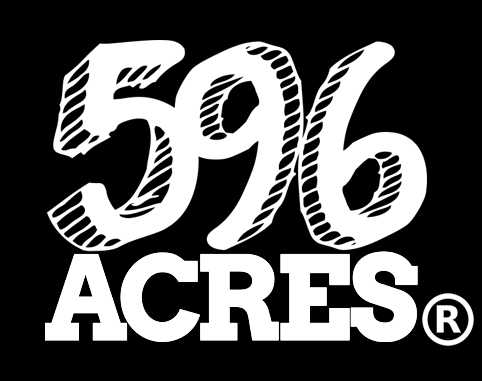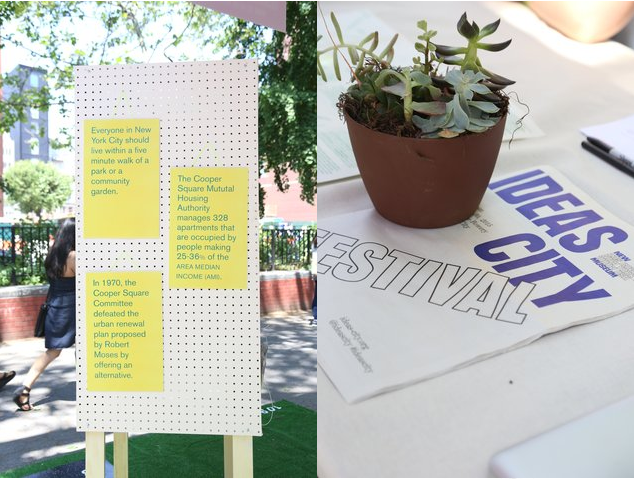“Gaining our freedom is, in the first place, ripping off a few acres from the face of a domesticated planet.”
–Attila Kotanyi and Raoul Vaneigem, “manifesto of unitary urbanism”
Invisible structures and invisible histories make cities as we know them, see them, smell them and dig in their soils. On the occasion of the Ideas City Festival, hosted by the New Museum, 596 Acres, Deborah Berke Partners and GRT Architects invite you on a tour of tax lot lines, leases, settled court cases, City-agency jurisdiction assignments, histories of organizing, memories of long meetings, cleared garbage heaps, community land trusts and New Yorkers struggling and succeeding to create and control the space of the City, together.
You can see a PDF of the printed map we handed out at the festival here.





Elizabeth Street Garden is the only green oasis in the Little Italy and SoHo neighborhood. The Garden, open to the public by volunteers, provides a beautiful sanctuary for local residents and workers. The site was transformed from a derelict lot into a garden in 1991 when Elizabeth Street Gallery leased the site from the New York City Department of Citywide Administrative Services.
In June 2013, neighbors came together to preserve the Garden permanently as a unique public green, open space. The community learned the Garden resides on city-owned land and in conjunction with the Seward Park Urban Renewal Area rezoning, the City committed to build housing on the site. In 2014, Community Board 2 passed a resolution supporting the permanent preservation of the Garden, in its entirety, as a NYC Park.
Since then, Friends of Elizabeth Street Garden has grown a volunteer base of nearly 400 people, established a nonprofit corporation, staffed and opened the Garden to the public year round and programmed more than 150 free public events—including gardening and educational programming for adults and children, wellness programming such as yoga, tai chi and meridian tapping, and an annual Harvest Festival attended by more than 2,000 neighbors.
Currently, the Garden has no protections as an official NYC park, garden or open space. The City can recognize its importance and protect it by transferring the land to the Parks Department. What can you do? Volunteer ONE hour a month to keep the Garden open for all! Email volunteer@elizabethstreetgarden.org.

El Jardin Del Paraiso, situated between E 4th and 5th Streets and Avenues C and D in the Lower East Side, was created as a green space by local residents in 1981 out of series of abandoned lots, some owned by the City and some owned by private entities. Homesteaders, gardeners, artists, religious leaders, the Junior League, and the principal of P.S. 15, worked together to advocate for the expansion and preservation of the garden as a permanent park. The group convinced the City that El Jardin was perfectly situated to become a new park for the Lower East Side in a part of the neighborhood badly served by the existing green spaces. The city condemned three adjacent privately owned lots that formerly divided the space during the 1990s using eminent domain, making the park whole.
The lots that El Jardin is on were transferred to the jurisdiction of the Parks Department in 1999 but have not yet been officially mapped as parkland; they also have buildable floor area and are zoned as residential land (R8B). The buildable area could be transferred as development rights to be used elsewhere or eliminated if the City officially maps El Jardin as parkland. Today, El Jardin Del Paraiso provides recreational green space for a diverse community to gather, and hosts a broad program of educational and garden events. In 2012, the park joined the neighborhood coalition LUNGS (Lower East Side Neighborhood Gardens), urging the city to officially create a Community Garden District in the Lower East Side and permanently preserve the remaining gardens in neighborhood.

In 2012, residents of the Lower East Side gained access to two parcels of city-owned vacant land near the corner of Stanton and Attorney Streets and created the Siempre Verde Garden. The parcels are in the inventory of Housing Preservation and Development. The lots had previously been a garden in the 1980s and 1990s. 596 Acres, New York’s community land access advocacy organization, had posted signs on the rusty fences surrounding the lots announcing that the land was publicly owned and that (re)creating the garden was possible. Neighbors who saw the signs connected with one another through 596 Acres and organized to get an interim use license through the New York City Parks Department Green Thumb program. Siempre Verde provides an inclusive recreational open space in an otherwise densely developed area.
The gardeners are in the midst of efforts to make the garden whole by having the City acquire a privately owned lot that divides the two garden parcels. This could happen through a purchase, a condemnation via eminent domain or a donation from the owner of that parcel. The development company that owns that lot is simultaneously campaigning to have the City parcels that the garden is on transferred to itself for new housing construction. The gardeners have so far been successful in preventing City approval of the developer’s plan and instead getting the local Community Board to unanimously request that the garden parcels be transferred to the Parks Department’s jurisdiction, where they will be more likely to be protected by state public trust doctrine. The City has not yet heeded the Community Board’s request; the lots continue to be sites of speculation and insecurity while the garden thrives.

The Cooper Square Committee (CSC) is a non-profit organization of Lower East Side residents preserving and developing affordable housing, community and cultural spaces. CSC formed in 1959 to fight the City of New York’s Cooper Square Slum Clearance plan, one of the first of the over 150 Urban Renewal Area Plans created and adopted for NYC’s “blighted” neighborhoods. The City plan was to bulldoze the buildings, move the residents and start over with a higher income population living in a less densely populated neighborhood. The CSC succeeded in resisting that plan and forced the City to adopt a their alternative plan, aimed at keeping the neighborhood racially, economically, and culturally diverse instead. The adoption of the community plan prevented the displacement of several thousand people as well as the demolition of over 300 buildings. In 1991, CSC created the Cooper Square Mutual Housing Association (MHA), now managing nearly 400 low-income cooperative apartments. The MHA owns the 21 buildings that these apartments are in; the Cooper Square Community Land Trust owns the land beneath the buildings and leases to the MHA on a renewable 99-year term. The mission of the Community Land Trust is make sure these 21 lots are used for affordable housing for low and moderate income people; covenants in the deeds to these lots give the Community Land Trust oversight power over the renter, the MHA. Residents own shares in the MHA that give them access to their units. This balanced system is the tool that CSC has used to permanently preserve affordable housing on some of the most expensive land in NYC.









